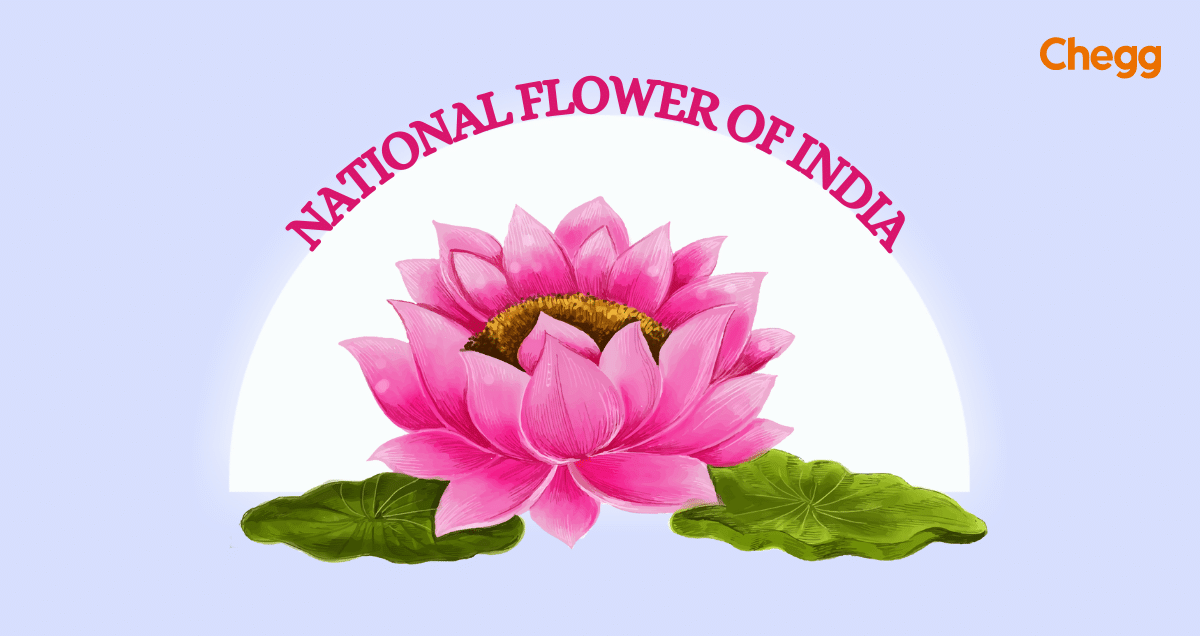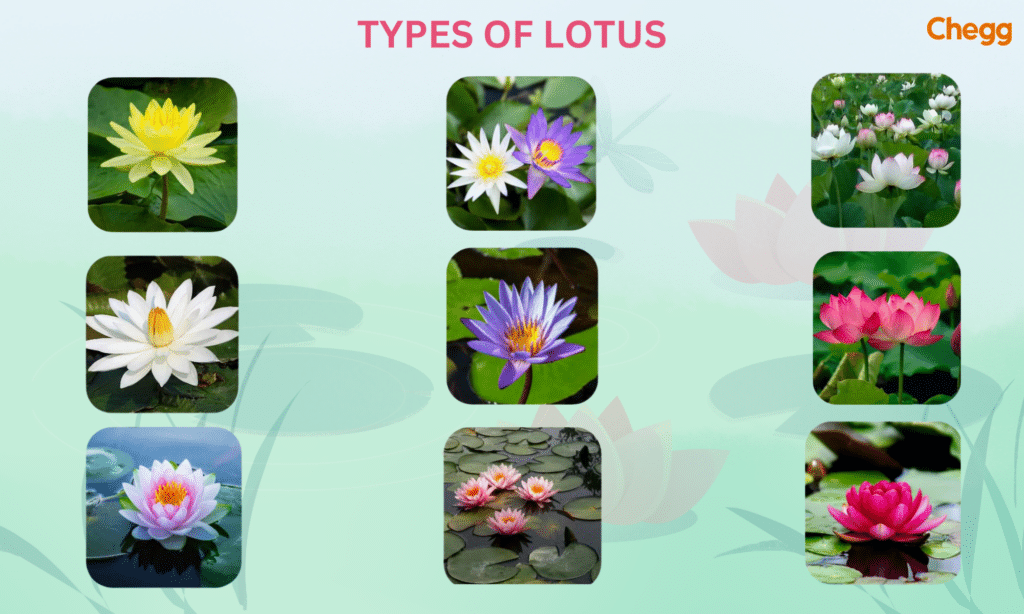
Quick Summary
The Lotus, National flower of India, is an aquatic plant known for its serene beauty and cultural significance.
Belonging to the Nymphaea family, its large pink blossoms with symmetrically arranged petals symbolize purity and elegance, making it a cherished emblem of the nation’s heritage.
It also holds a sacred place in Indian religions like Hinduism and Buddhism.
Table of Contents
The National Flower of India is the Lotus. India’s national flower is the water lily, or lotus, a member of the Nymphaea family of aquatic plants. The broad, floating petals and symmetrically arranged petals of the large, eye-catching pink blossoms convey an air of elegance and tranquillity.
Since Hindus, who represent a significant percentage of the Indian population, hold them in high regard, plenty of legends, religious mythology, and folklore surround them. It is thought to represent victory, honour, longevity, and good fortune. Lotus is a symbol of survival and purity of heart, mind, and spirit in all situations. It can re-germinate for thousands of years and can live in both freshwater and shallow waters and muddy wetlands.

| National Flower of India Overview | Details |
|---|---|
| Flower | Lotus |
| Scientific Name | Nelumbo Nucifera Gaertn |
| Significance | Purity, beauty, and spirituality |
| Cultural Importance | Sacred in Indian religions like Hinduism and Buddhism |
| Habitat | Grows in wetlands, ponds, and lakes |
The Lotus, cherished as the National Flower of India, holds deep cultural, spiritual, and symbolic significance. While the Botanical Survey of India clarified in 2017 that no flower was officially designated as the national flower, government resources widely acknowledge the lotus as such. This flower, also known as the “water lily” is admired for its beauty, resilience, and connection to Indian heritage. Its ability to thrive in muddy water symbolizes purity, strength, and overcoming challenges. The lotus also holds spiritual importance, often linked to deities and ancient tales.
The lotus is a timeless reminder of India’s rich heritage and values.
The national flower of India does not hold significance merely because of its appealing beauty and grace. The flower also stands out as unique and different from others with its distinctive botanical features. The lotus flower, meaning water lily belonging to the Nelumbo species, showcases intriguing biological characteristics:
The Indian national flower seamlessly integrates aquatic adaptations, captivates aesthetics, and cultural symbolism, and emerges as a botanical marvel intricately woven into human heritage.
The lotus, or Nelumbo nucifera, is India’s national flower and comes with a lot of meaning and uses. Here are the main ways the lotus is used in different areas:
The Lotus means much more than what our visions will ever witness. The national flower of India embodies an array of meanings across diverse cultures and contexts. Some of the critical meanings are:
These meanings show why the lotus is a strong symbol. It connects with change, spirituality, and the natural beauty of life.
The lotus is the national flower of India. This choice is deeply connected to culture and has important historical and spiritual meaning. This selection showcases the flower’s esteemed position within Indian culture, entwined with spiritual, artistic, and philosophical dimensions. The cultural significance of the national flower of India is:
The lotus’s symbolism traverses religious boundaries, uniting people. It’s revered in Hinduism, Buddhism, Jainism, and other faiths, representing values diverse communities share. The national flower of India is the lotus. It is important in ancient Indian texts and scriptures. The lotus appears in religious, literary, and historical stories. This shows its lasting cultural significance. Indian mythology also often portrays the lotus as the seat of deities, amplifying its significance within divine contexts. Therefore, selecting the lotus as India’s national flower goes beyond its visual beauty. Its cultural richness and spiritual importance make it an important symbol of India. It represents the country’s diverse culture and enduring values.
In Buddhism, the lotus flower has a deep meaning. Its colours and stages of bloom show different parts of spiritual growth and enlightenment. Each colour has its meaning. White stands for purity of mind and spirit. Red represents love and compassion. Blue signifies wisdom and logic. Pink reflects the history of the Buddha. Purple embodies spirituality and mysticism. Gold represents ultimate enlightenment. The flower’s state—closed or fully open—depicts the stages of enlightenment, from ignorance to full awareness.
There is more about the lotus flower than just a symbol of the national flower of India. Beyond India, the lotus flower holds diverse symbolic meanings in various cultures worldwide. Some of the countries that show great importance to our national flower are:
| Region | Symbolism of the Lotus |
|---|---|
| Egypt | Represented rebirth, akin to the rising sun each day. Linked to the Nile River’s annual flood, symbolizing prosperity. |
| China | Valued for its ability to grow in mud yet produce beautiful flowers, symbolizing purity, wisdom, and inner growth. |
| Japan | Represents purity, wisdom, and resilience in adversity. Associated with Kannon, the kind and compassionate goddess. |
| Tibet | Symbolizes transformation and spiritual growth, growing from mud to beauty. Used in art to signify purity and overcoming challenges. |
| Ancient Greece | Linked to rejuvenation and a youthful spirit. Featured in myths, like the story of the lotus-eaters, representing comfort and renewal. |
| Vietnam | Emblem of beauty, purity, and inner strength in adversity. A cultural symbol akin to its role in India. |
The lotus flower is a symbol of purity, enlightenment, and growth in many cultures. Its meaning is important in human history.
The national flower of India plays an important role in many Indian festivals. Its deep meaning of purity, divinity, and spiritual awakening adds to cultural celebrations
Across these festivals, lotus flowers enrich celebrations by adding cultural depth.

The national flower of India, the Lotus, has great symbolic meaning. It has inspired creativity in art, poetry, and literature in many cultures. Its grace adorns paintings, sculptures, and architecture, often embodying purity and divinity. Employed metaphorically, it signifies beauty, growth, and transformation, evoking sensory impressions. The flower is also woven into myths and narratives. It imparts allegorical layers and embodies spiritual awakening. This enduring influence underscores the lotus’s universal appeal as a symbol of beauty, growth, and spiritual enlightenment.
Also Read:-
The National Tree of India: Banyan Tree
National Bird of India: An Overview
National Vegetable of India: Indian Pumpkin or Kaddu
What is the National Food of India? Top Dishes, Cultural Significance & Regional Flavors
| State | Common Name | Scientific Name |
|---|---|---|
| Andhra Pradesh | Jasmine | Jasminum officinale |
| Arunachal Pradesh | Foxtail Orchid | Rhynchostylis retusa |
| Assam | No flower specified | |
| Bihar | Kachnar | Bauhinia variegata |
| Goa | Red Jasmine | Plumeria rubra |
| Gujarat | Marigold | Tagetes erecta |
| Haryana | Lotus | Nelumbo nucifera |
| Himachal Pradesh | Pink Rhododendron | Rhododendron campanulatum |
| Jharkhand | Palash | Butea monosperma |
| Karnataka | Lotus | Nelumbo nucifera |
| Kerala | Golden Shower | Cassia fistula |
| Madhya Pradesh | Palash | Butea monosperma |
| Maharashtra | Jarul | Lagerstroemia speciosa |
| Manipur | Siroi Lily | Lilium mackliniae |
| Meghalaya | Lady’s Slipper Orchid | Paphiopedilum insigne |
| Mizoram | Red Vanda | Renanthera imschootiana |
| Nagaland | Rhododendron | Rhododendron arboreum |
| Odisha | Ashoka | Saraca asoca |
| Punjab | Sword Lily | Gladiolus grandiflorus |
| Rajasthan | Rohira | Tecomella undulata |
| Sikkim | Noble Orchid | Cymbidium goeringii |
| Tamil Nadu | Glory Lily | Gloriosa superba |
| Telangana | Tanner’s Cassia | Senna auriculata |
| Tripura | Nageswar | Mesua ferrea |
| Uttar Pradesh | Palash | Butea monosperma |
| Uttarakhand | Brahma Kamal | Saussurea obvallata |
| West Bengal | Night-Flowering Jasmine | Nyctanthes arbor-tristis |
If you’re wondering, “When is National Flower Day in India?” or “When is the National Flower Day celebrated in the World?” There are several celebrations held all year long. Every occasion showcases another aspect of the floral sector. It’s a festive and diverse celebration. Below is an explanation of various events:
In talks about this holiday, the question “What is the national flower of India?” frequently comes up. Every country proudly names a particular flower that has symbolic, historical, or cultural value. This variety captures the complex range of floral appeal.
Japan, for instance, is famous for its cherry blossoms. The regal rose is a famous plant in England. The National Flower of India is the Lotus. We are invited to recognize the distinctive worth that every national flower carries on this day.

The lotus flower information is far beyond its captivating beauty and spiritual qualities. Due to its symbolism encompassing purity, grace, fertility, self-regeneration, serenity, and divine attributes, our national flower is often positioned alongside revered deity figures. Much like other flowers, each lotus shade holds its distinct significance. The white lotus symbolizes purity and tranquillity, while the yellow variant aligns with spiritual ascension.
The lotus can renew itself in beautiful ways. Its leaves have a waxy coating that keeps it looking good each morning. The lotus does not give up easily. This makes it a symbol of strong faith.
1. Strong Roots – Lotus plants hold themselves in place with special roots that get nutrients from the mud underwater.
2. Floating Leaves – Lotus leaves are big, round, and waxy. They stay dry because they have air inside, so water can’t stick to them.
3. Pretty Flowers – Lotus flowers sit on tall stems above the water, and they look like cups made of many petals.
4. Reproduction – Lotus plants have both male (stamen) and female (carpel) parts for making more lotus plants.
5. Growing Seeds – The seed pods start growing underwater and then come up to the surface. When they’re ready, they let seeds out through small holes.
The National Symbols of India reflect the country’s heritage, unity, and pride, making them vital elements of national identity. The lotus is the National Flower of India. It represents beauty and non-attachment. The lotus grows well in muddy water. This shows its resilience and beauty. It has cultural and spiritual importance. It is often celebrated in Indian literature for its link to purity and the sun. These symbols, found in the India Yearbook, inspire love for our country. They show India’s rich variety of plants and animals. India ranks fourth in Asia for plant diversity.
The national flower of India, the lotus, is a profound symbol that encapsulates the essence of purity, beauty, and spiritual awakening. This exquisite flower, which rises majestically from muddy waters, serves as a powerful metaphor for the human experience, illustrating how one can emerge from challenging circumstances to achieve greatness. The lotus is deeply intertwined with India’s cultural heritage, representing not only the aesthetic beauty found in nature but also the philosophical and spiritual values that have shaped the nation over millennia.

Ans. The national flower of India is the Lotus, a symbol of purity and beauty in Indian culture. It is also deeply associated with spirituality and is revered in many religions like Hinduism and Buddhism.
Ans. The lotus was chosen as India’s national flower due to its deep-rooted cultural significance and spiritual symbolism.
Ans. The golden lotus symbolizes spiritual enlightenment, purity, and divine perfection in Buddhism. It represents the ultimate achievement of awakening and transcending worldly attachments.
Ans. The lotus or the “water lily” can survive in fresh, muddy water environments.
Ans. The lotus flower holds sacred importance because of its purity, hope, resilience, and spiritual development.
Ans. The lotus represents purity, enlightenment, and rebirth. It also signifies resilience, as it rises beautifully from muddy waters.
Ans. The scientific name of the lotus is Nelumbo Nucifera Gaertn.
Ans. The lotus is associated with several Hindu deities, including Brahma, Vishnu, Lakshmi, and Ganesha, symbolizing purity, divinity, and prosperity.

Authored by, Amay Mathur | Senior Editor




Amay Mathur is a business news reporter at Chegg.com. He previously worked for PCMag, Business Insider, The Messenger, and ZDNET as a reporter and copyeditor. His areas of coverage encompass tech, business, strategy, finance, and even space. He is a Columbia University graduate.
Editor's Recommendations
Chegg India does not ask for money to offer any opportunity with the company. We request you to be vigilant before sharing your personal and financial information with any third party. Beware of fraudulent activities claiming affiliation with our company and promising monetary rewards or benefits. Chegg India shall not be responsible for any losses resulting from such activities.
Chegg India does not ask for money to offer any opportunity with the company. We request you to be vigilant before sharing your personal and financial information with any third party. Beware of fraudulent activities claiming affiliation with our company and promising monetary rewards or benefits. Chegg India shall not be responsible for any losses resulting from such activities.